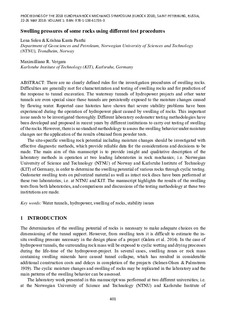| dc.contributor.author | Selen, Lena | |
| dc.contributor.author | Panthi, Krishna Kanta | |
| dc.contributor.author | Vergara, Maximilliano R. | |
| dc.date.accessioned | 2019-01-25T14:57:22Z | |
| dc.date.available | 2019-01-25T14:57:22Z | |
| dc.date.created | 2018-08-13T15:54:43Z | |
| dc.date.issued | 2018 | |
| dc.identifier.isbn | 978-1-138-61645-5 | |
| dc.identifier.uri | http://hdl.handle.net/11250/2582448 | |
| dc.description.abstract | There are no clearly defined rules for the investigation procedures of swelling rocks. Difficulties are generally met for characterization and testing of swelling rocks and for prediction of the response to tunnel excavation. The waterway tunnels of hydropower projects and other water tunnels are even special since these tunnels are persistently exposed to the moisture changes caused by flowing water. Reported case histories have shown that severe stability problems have been experienced during the operation of hydropower plant caused by swelling of rocks. This important issue needs to be investigated thoroughly. Different laboratory oedometer testing methodologies have been developed and proposed in recent years by different institutions to carry out testing of swelling of the rocks. However, there is no standard methodology to assess the swelling behavior under moisture changes nor the application of the results obtained from powder tests. The site-specific swelling rock potential including moisture changes should be investigated with effective diagnostic methods, which provide reliable data for the considerations and decisions to be made. The main aim of this manuscript is to provide insight and qualitative description of the laboratory methods in operation at two leading laboratories in rock mechanics; i.e. Norwegian University of Science and Technology (NTNU) of Norway and Karlsruhe Institute of Technology (KIT) of Germany, in order to determine the swelling potential of various rocks through cyclic testing. Oedometer swelling tests on pulverized material as well as intact rock discs have been performed at these two laboratories; i.e. at NTNU and KIT. The manuscript highlights the results of the swelling tests from both laboratories, and comparisons and discussions of the testing methodology at these two institutions are made. | nb_NO |
| dc.language.iso | eng | nb_NO |
| dc.publisher | CRC Press | nb_NO |
| dc.relation.ispartof | Geomechanics and Geodynamics of Rock Masses | |
| dc.title | Swelling pressures of some rocks using different test procedures | nb_NO |
| dc.title.alternative | Swelling pressures of some rocks using different test procedures | nb_NO |
| dc.type | Chapter | nb_NO |
| dc.description.version | acceptedVersion | nb_NO |
| dc.source.pagenumber | 401-409 | nb_NO |
| dc.identifier.doi | 10.1201/9780429462078 | |
| dc.identifier.cristin | 1601662 | |
| dc.relation.project | Norges forskningsråd: 257588 | nb_NO |
| dc.description.localcode | Locked until 15.5.2019 due to copyright restrictions. This is an Accepted Manuscript of a book chapter published by Routledge/CRC Press in [Geomechanics and Geodynamics of Rock Masses: Proceedings of the 2018 European Rock Mechanics Symposium] on [15 May 2018], available online: https://doi.org/10.1201/9780429462078 | nb_NO |
| cristin.unitcode | 194,64,90,0 | |
| cristin.unitname | Institutt for geovitenskap og petroleum | |
| cristin.ispublished | true | |
| cristin.fulltext | postprint | |
